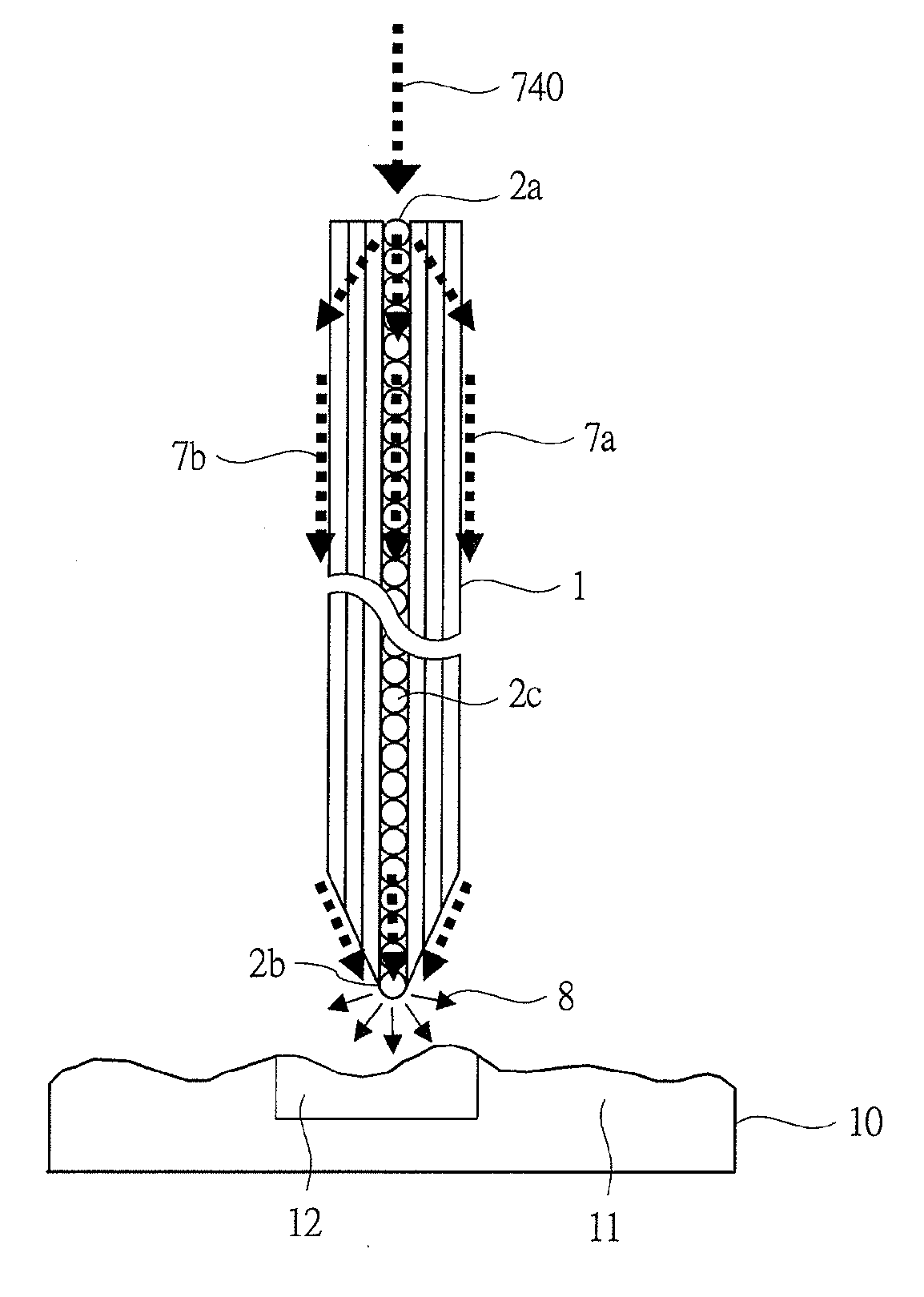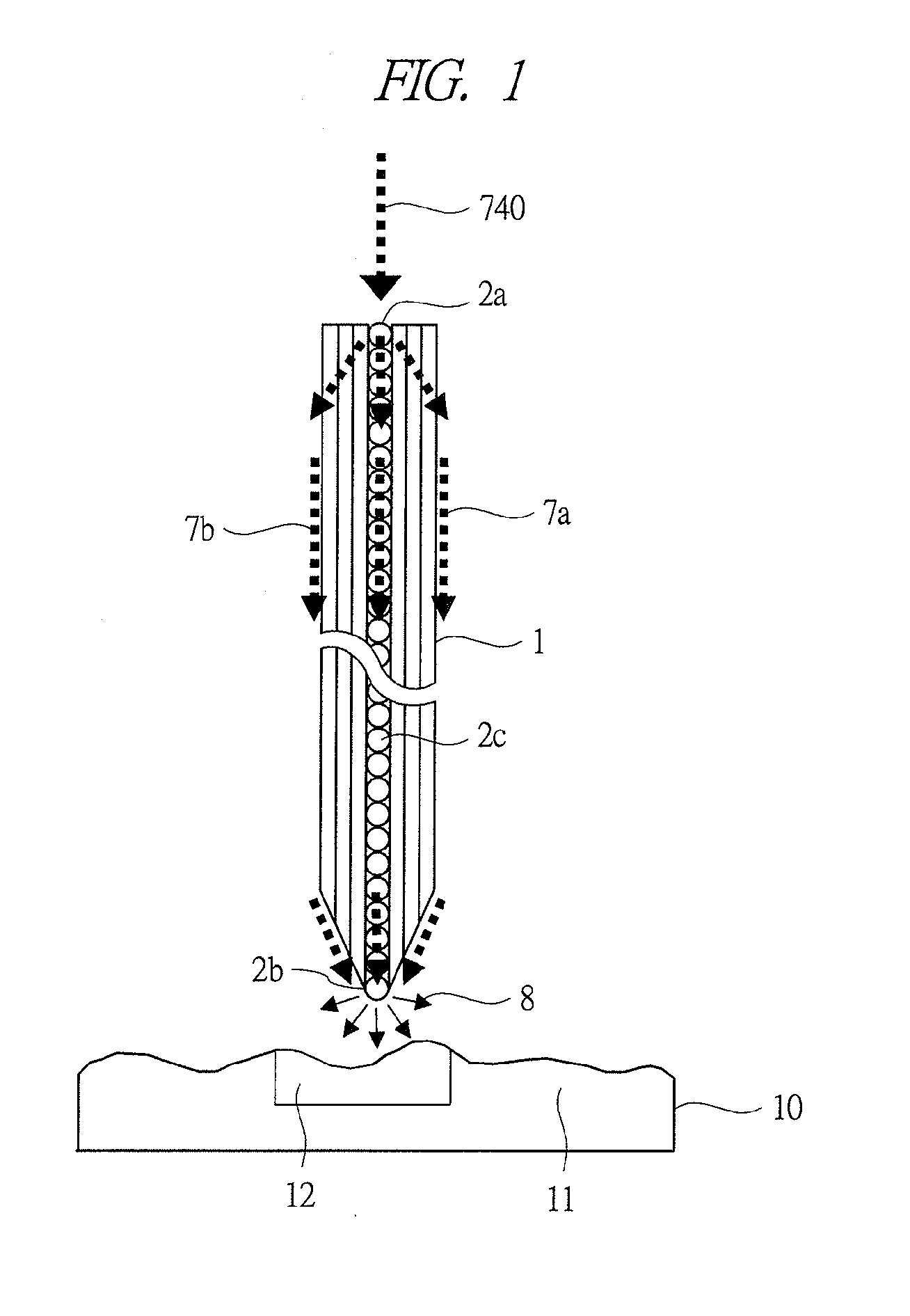Scanning probe microscope and method of observing sample using the same
a probe microscope and probe technology, applied in the field of scanning probe microscopes, can solve the problems of limited apertures to several tens of nm, and achieve the effects of reducing the reproducibility of measured images, difficult stably forming apertures, and extremely low measurement repeatability
- Summary
- Abstract
- Description
- Claims
- Application Information
AI Technical Summary
Benefits of technology
Problems solved by technology
Method used
Image
Examples
first embodiment
[0058]A first embodiment of the present invention is described with reference to FIGS. 1 to 20.
[0059]First, a configuration of a plasmon-enhanced near-field probe according to the present embodiment is described with reference to FIGS. 1 to 3. In the present embodiment, as illustrated in FIG. 1, the plasmon-enhanced near-field probe is formed by sharpening a bottom end portion in a nanotube 1 as a circular cone shape, the nanotube 1 such as a multilayered carbon nanotube (CNT), a metal nanotube, or a boron nitride (BN) nanotube having properties as an insulator, and by filling spherical gold nano-particles 2 (2a, 2c, and 2b) made of gold (Au) in a top end portion, an inside, and a bottom end portion of a hollow portion inside the nanotube 1.
[0060]For example, a voltage is applied to both ends of the nanotube, 1 such as a carbon nanotube, and a current is saturated in time as increasing the applied voltage. As further increasing the applied voltage, the current is decreased step by s...
second embodiment
[0130]A second embodiment according to the present invention is described with reference FIG. 21. FIG. 21 illustrates, in the plasmon exciting unit 200 according to the present embodiment, a method of fixing the nanotube 1 to the chip 730 and a principle of guiding the excited TM mode plasmon 740 toward the nanotube 1. In the plasmon exciting unit according to the first embodiment described above, three gold dots 750a are formed by the irradiation of electron beams, and these gold dots are used as a binder to be melted to adhere the nanotube 1 on the tip of the chip 730. Also, in consideration of ensuring sufficient strength for the fixing and achieving the coupling efficiency of the plasmon to the nanotube having a diameter of 20 nm, it is set in the first embodiment described above such that D=40 nm, H=40 nm, and the distance P=250 nm.
[0131]In the present embodiment, for the gold dot 750a at the incident end portion in the nanotube 1, it is set such that D=40 nm and H=40 nm in con...
third embodiment
[0135]A third embodiment according to the present invention is described with reference FIG. 22. FIG. 22 illustrates, in the plasmon exciting unit 200 according to the present embodiment, a method of fixing the nanotube 1 to the chip 730 and a principle of guiding the excited TM mode plasmon 740 toward the nanotube 1. In the plasmon exciting unit according to the first embodiment described above, three gold dots 750a are formed by the irradiation of electron beams, and these gold dots are used as a binder to be melted to adhere the nanotube 1 on the tip of the chip 730. Also, in consideration of ensuring sufficient strength for the fixing and achieving the coupling efficiency of the plasmon to the nanotube having a diameter of 20 nm, it is set in the first embodiment described above such that D=40 nm, H=40 nm, and the distance P=250 nm.
[0136]In the present embodiment, for the gold dot 750a at the incident end portion in the nanotube 1, it is set such that D0=40 nm and H0=40 nm in co...
PUM
 Login to View More
Login to View More Abstract
Description
Claims
Application Information
 Login to View More
Login to View More - R&D
- Intellectual Property
- Life Sciences
- Materials
- Tech Scout
- Unparalleled Data Quality
- Higher Quality Content
- 60% Fewer Hallucinations
Browse by: Latest US Patents, China's latest patents, Technical Efficacy Thesaurus, Application Domain, Technology Topic, Popular Technical Reports.
© 2025 PatSnap. All rights reserved.Legal|Privacy policy|Modern Slavery Act Transparency Statement|Sitemap|About US| Contact US: help@patsnap.com



